《学案与测评》2011届高考英语总复习语法提升课件:专题5动词的时态和语态
文档属性
| 名称 | 《学案与测评》2011届高考英语总复习语法提升课件:专题5动词的时态和语态 | 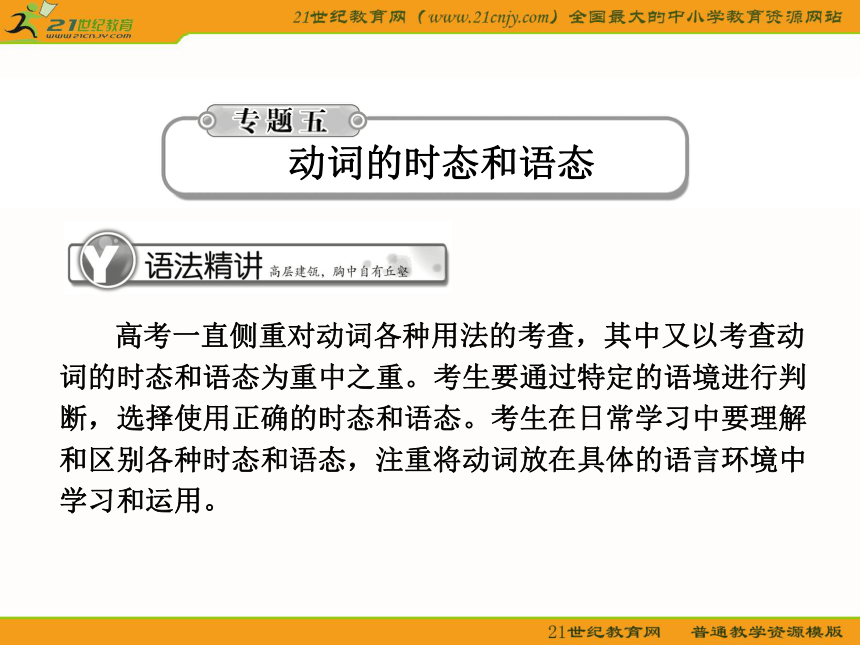 | |
| 格式 | rar | ||
| 文件大小 | 162.2KB | ||
| 资源类型 | 教案 | ||
| 版本资源 | 通用版 | ||
| 科目 | 英语 | ||
| 更新时间 | 2010-12-09 17:42:00 | ||
图片预览

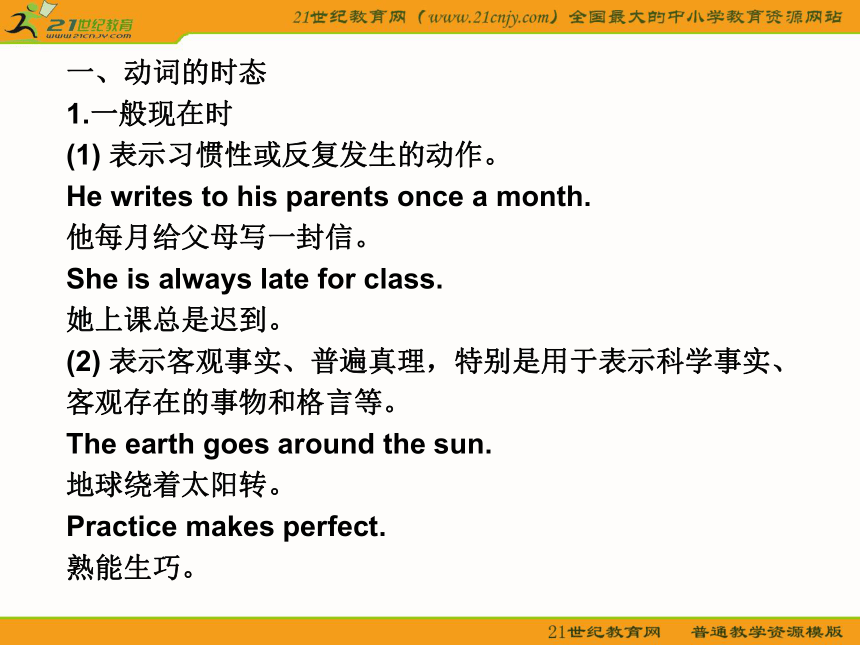


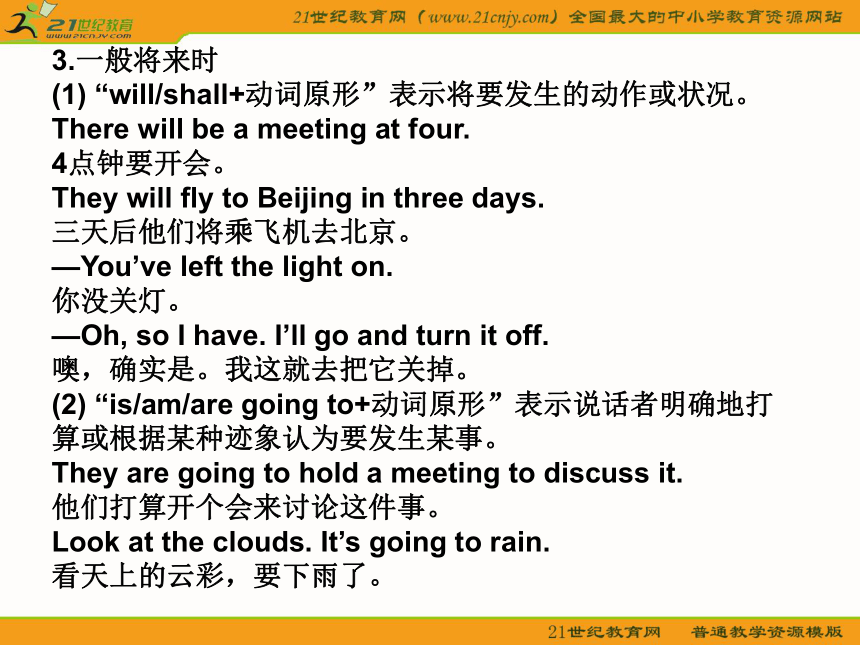

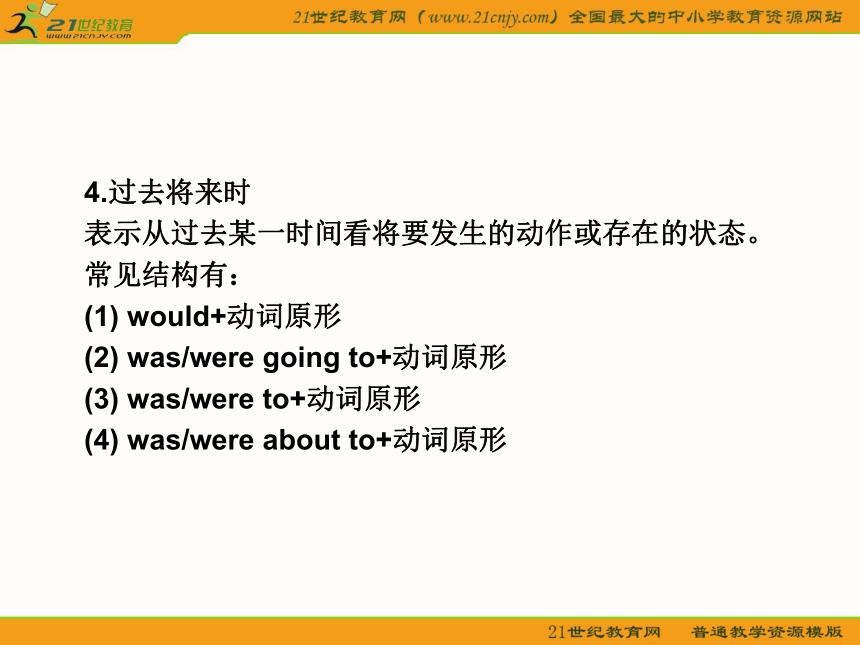

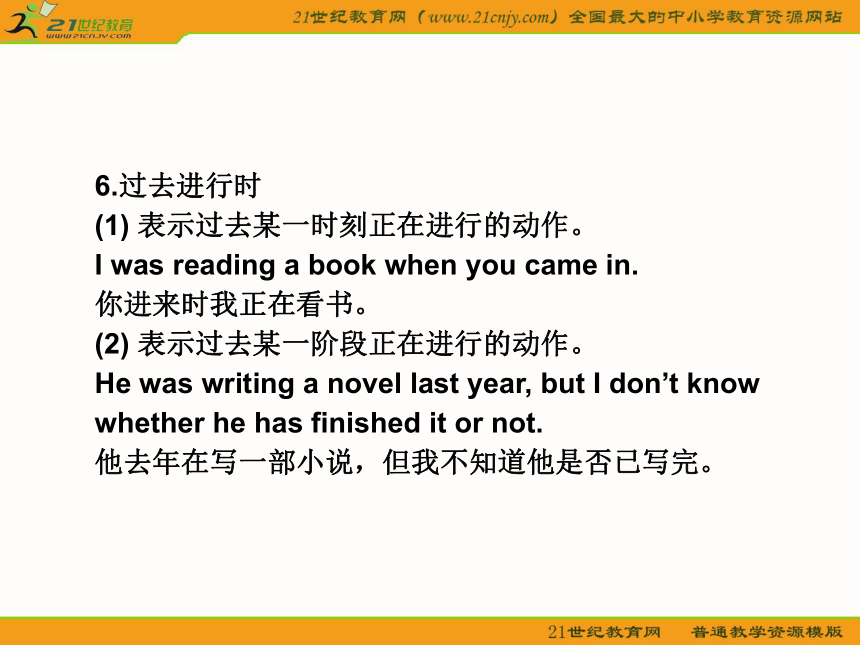
文档简介
课件24张PPT。动词的时态和语态 高考一直侧重对动词各种用法的考查,其中又以考查动词的时态和语态为重中之重。考生要通过特定的语境进行判断,选择使用正确的时态和语态。考生在日常学习中要理解和区别各种时态和语态,注重将动词放在具体的语言环境中学习和运用。一、动词的时态
1.一般现在时
(1) 表示习惯性或反复发生的动作。
He writes to his parents once a month.
他每月给父母写一封信。
She is always late for class.
她上课总是迟到。
(2) 表示客观事实、普遍真理,特别是用于表示科学事实、客观存在的事物和格言等。
The earth goes around the sun.
地球绕着太阳转。
Practice makes perfect.
熟能生巧。 (3) 表示现阶段存在的状态。
I don’t agree with you.
我不同意你的观点。
The book is mine.
这本书是我的。
(4) 一些动词如:come,go,leave,arrive,return,start,begin等常用一般现在时表示将来意义上的时间,表示按规定、计划或安排将要发生的动作。
The term starts at the beginning of September.
这个学期从九月份开始。
(5) 在时间、条件状语从句中常用一般现在时代替将来时。
When he arrives, he’ll tell us all about the match.
当他到的时候,他会告诉我们这场比赛的经过。
I can’t come unless my brother agrees.
我不能来,除非我哥哥同意。 2.一般过去时
(1) 表示过去某一时刻或一段时间内发生过的动作或存在的状态。
I wasn’t in last night.
昨晚我不在家。
(2) 表示过去的习惯性动作。
When he was a child, he often swam in the river.
当他还是小孩儿的时候,经常在这条河里游泳。
(3) 在条件从句中表示与现在或将来事实相反的假设。
If I were you, I wouldn’t accept the offer.
如果我是你,我不会接受这个提议。
(4) 用于I wish, I’d rather, It’s (high) time后的that从句中,表示与现在或将来的事实相反的主观设想。
It’s time you went to bed.
你该睡觉了。 3.一般将来时
(1) “will/shall+动词原形”表示将要发生的动作或状况。
There will be a meeting at four.
4点钟要开会。
They will fly to Beijing in three days.
三天后他们将乘飞机去北京。
—You’ve left the light on.
你没关灯。
—Oh, so I have. I’ll go and turn it off.
噢,确实是。我这就去把它关掉。
(2) “is/am/are going to+动词原形”表示说话者明确地打算或根据某种迹象认为要发生某事。
They are going to hold a meeting to discuss it.
他们打算开个会来讨论这件事。
Look at the clouds. It’s going to rain.
看天上的云彩,要下雨了。(3) “is/am/are to+动词原形”表示计划安排做某事或命令做某事。
I am to meet Mr Brown at eleven this morning.
我要在今天上午11点见布朗先生。
You are to return the book before Friday.
你务必在星期五之前归还这本书。
(4) “is/am/are about to+动词原形”表示即将要发生的动作,但不可与将来的时间状语连用,如soon, tomorrow, immediately等。
The meeting is about to begin.
会议就要开始了。
They are about to start.
他们即将动身。4.过去将来时
表示从过去某一时间看将要发生的动作或存在的状态。
常见结构有:
(1) would+动词原形
(2) was/were going to+动词原形
(3) was/were to+动词原形
(4) was/were about to+动词原形5.现在进行时
(1) 表示说话时正在进行的动作。
I am waiting for the bus.
我正在等公共汽车。
(2) 表示现阶段正在进行的动作。
He is translating a book.
他正在翻译一本书。
(3) 有些动词如:arrive, go, come, start, leave,stay,begin等的现在进行时可以表示将来的动作。
My grandmother is coming to see me next week.
我奶奶下周要来看我。
(4) 与always,constantly等时间副词连用,表示不满、抱怨或赞赏等情感。
She is always finding fault with others.
她老是挑别人的毛病。
John is always thinking of others.
约翰总是为别人着想。6.过去进行时
(1) 表示过去某一时刻正在进行的动作。
I was reading a book when you came in.
你进来时我正在看书。
(2) 表示过去某一阶段正在进行的动作。
He was writing a novel last year, but I don’t know whether he has finished it or not.
他去年在写一部小说,但我不知道他是否已写完。7.将来进行时
(1) 表示将来某时刻正在进行的动作。
What will you be doing at this time next Monday?
下星期一的这个时间你会在做什么?
When he comes to my house tomorrow, I will be writing the report. 明天他来我家时,我将会在写报告。
(2) 表示预定的将来的动作或对将来的预测。
I will be working in the department store next month.
下个月我将在这个百货大楼里上班。
After you take the medicine, you will be feeling much better.
服药之后你会感觉好得多。8.现在完成时
(1) 表示到现在为止的一段时间内发生的情况或动作,强调的是对现在的影响,可能是已经完成的动作,也可以表示多次动作的总和,或习惯性的行为。
I have cut my finger.
我割破了手。
I’ve always walked to school.
我一直步行去学校。
(2) 表示一个动作发生在过去,但一直延续到现在,并可能继续进行下去,这时常常与表示一段时间的状语连用。
I have studied English for four years.
我学英语已经有四年了。
He has lived in Shanghai since 1992.
自从1992年以来他一直住在上海。
(3) 现在完成时用于将来的情况,即:主句为一般将来时,时间和条件从句中的谓语用现在完成时表示将来某时刻完成的动作。
I’ll lend the magazine to you as soon as I’ve finished reading it. 我一看完这本杂志就借给你。9.过去完成时
(1) 过去完成时表示在过去某一动作或时间之前,另一个动作已经结束,它强调“过去的过去”。
When I got to the airport, the flight had taken off.
当我到达机场时,飞机已经起飞了。
He told me he had finished all the work.
他告诉我他已完成了所有的工作。
By the end of that month Jack had collected more than a hundred foreign stamps.
到那个月底,杰克已收集了一百多张外国邮票。 (2) 在由if, if only, as if, as though, I’d rather, I wish等引导的从句中,表示与过去事实相反的主观愿望或想法。
If the driver had been careful enough, all the passengers would be safe now.
如果这个司机能足够小心,那么所有的乘客现在就都安全了。
(3) intend,mean,hope,want,think,plan等动词的过去完成时可表示一种未实现的愿望或想法。
They had wanted to come to help us, but couldn’t get here in time.
他们本想来帮助我们,但没能及时赶到这里。10.将来完成时
将来完成时表示在将来某个日期或某一动作发生之前,另一个动作将要结束。
They’ll have hit the year’s target by the end of October.
到十月份末他们将会实现年度目标。
By next month I will have studied German for just two years.
到下个月我学德语正好两年了。
11.现在完成进行时
现在完成进行时主要表示从过去某一时间开始一直延续到现在的动作,这个动作可能仍然在进行,也可能停止了一会儿。
She is ill. She’s been lying in the bed for two weeks.
她病了,已经卧床两个星期了。
We have been looking for you for an hour.
我们找了你一个小时了。12.过去完成进行时
过去完成进行时表示动作从过去某一时间之前开始,到过去某一时间仍在进行或刚刚结束,必须以某一特定的过去时间为前提。
He told me he had been writing the paper for one month.
他告诉我他写论文已经一个月了。
I had been ringing outside for half an hour before she called me in. 在她叫我进去之前,我已经在外面等了半个小时了。二、动词的语态
动词的语态有两种:一是主动语态,二是被动语态。主语是动作的发出者,则为主动语态;主语是动作的承受者,则为被动动态。
1.被动语态的构成
被动语态主要由“助动词be+及物动词的过去分词”构成;而时态则由助动词的各种变化来表示,要注意助动词be的时态必须与相应的主动句保持一致。被动语态还可以由get构成,这也是高考试题中常出现的语言点之一。
John was fired last week.
约翰上周被解雇了。
My finger got badly burnt, now it becomes swollen.
我的手指被伤得很重,现在肿起来了。
可与get相搭配的过去分词有:
broken, burnt, killed, hurt, washed, lost, confused, married, dressed, divorced, engaged等。 2.被动语态的时态
一般现在时: is (am, are)+过去分词
一般过去时: was (were)+过去分词
现在进行时: is (am, are)+being+过去分词
过去进行时: was (were) +being+过去分词
现在完成时: have (has)+been+过去分词
过去完成时: had +been+过去分词
一般将来时: shall (will)+be+过去分词
过去将来时: should (would)+be +过去分词3. 主动表示被动的几种情况:
(1) 不及物动词与状语连用,用以表示主语的品质和状态。
常见的动词有:cut,sell,read,write,cook,lock,wash,drive,keep等。
These books sell well.
这些书销售得不错。
The pen writes smoothly.
这支笔写起来很流畅。
Meat won’t keep long in such hot weather.
肉在这样热的天气里不宜久放。(2) 连系动词的主动式+形容词。
常见动词(短语)有:look,smell,taste,sound,feel,turn out等。
The apples taste good.
这些苹果很好吃。
The flower smells wonderful.
这花闻起来很香。
Cotton feels soft.
棉花摸起来很柔软。
(3) 不定式用在某些形容词之后,且与主语有动宾关系。
常见形容词有:hard,difficult,easy,heavy,fit,good,comfortable,convenient等。
The question is difficult to answer.
这个问题难以回答。
The box is heavy to carry.
这个盒子搬着很沉。例1:—Why does the lake smell terrible?
-Because large quantities of water .(2009·福建)
A. have polluted B. is being polluted
C. has been polluted D. have been polluted
解析:选D。考查动词时态,语态和主谓语一致。根据前一分句可知,所填动词表示过去发生的动作对现在产生的影响,故时态用现在完成时;动词与主语是被动关系,故用被动语态。主语是large quantities of water,其中心词是quantities,为复数,谓语动词用复数,故选D。
例2:According to the literary review, Shakespeare his characters live through their language in his plays. (2009·福建)
A. will make B. had made C. was making D. makes
解析:选D。考查动词时态。题干是陈述一个客观事实,用一般现在时,故选D。例3:Would you please keep silent? The weather
report and I want to listen.(2009·湖南)
A. is broadcast B. is being broadcast
C. has been broadcast D. had been broadcast
解析:选B。考查时态和语态。句意为:请保持安静行吗? 我想听正在播放的天气预报。说话时正在发生的动作,应用进行时,同时表示被动含义。故选B。
例4:—The food here is nice enough.
—My friend me a right place.(2009·湖南)
A. Introduces B. introduced
C. had introduced D. was introducing
解析:选B。考查时态的用法。句意为:——这里的食物不错。——我的朋友给我介绍了一个正确的地方。表示过去的行为。例5:I was out of town at the time, so I don?t know exactly how it . (2009·山东)
A. was happening B. happened
C. Happens D. has happened
解析:选B。考查具体语境中的时态,后半句隐藏的时间状语是at the time。
例6:This is the first time we a film in the cinema together as a family. (2009·陕西)
A. See B. had seen C. saw D. have seen
解析:选D。考查动词时态。“This is the+序数词+time”引导的时间状语从句中动词时态用现在完成时。故选D。例7:—Why don’t we choose that road to save time?
—The bridge to it . (2009·四川)
A. has repaired B. is repaired
C. is being repaired D. will be repaired
解析:选C。考查时态和语态。根据语境可知,不走另一条路的原因是因为桥正在被修。所以用现在进行时的被动语态作为该题的答案。
例8:Daniel’s family their holiday in Huangshan this time next week.(2009·安徽)
A. are enjoying B. are to enjoy
C. will enjoy D. will be enjoying
解析:选D。考查时态的用法。表示在将来的某个时间点做某事用将来进行时。例9:She stared at the painting, wondering where
she it.(2009·重庆)
A. Saw B. has seen C. sees D. had seen
解析:选D。考查时态的用法。根据句意,“以前在什么地方看过这幅画”应在stared之前,所以用过去完成时。
例10:Over the past decades, sea ice in the Arctic as a result of global warming.(2009·浙江)
A. had decreased B. decreased
C. has been decreasing D. is decreasing
解析:选C。考查时态的用法。根据句意,“北冰洋上的冰在过去的几十年里一直在减少”,可知这种状况依然在持续,所以使用现在完成进行时。
1.一般现在时
(1) 表示习惯性或反复发生的动作。
He writes to his parents once a month.
他每月给父母写一封信。
She is always late for class.
她上课总是迟到。
(2) 表示客观事实、普遍真理,特别是用于表示科学事实、客观存在的事物和格言等。
The earth goes around the sun.
地球绕着太阳转。
Practice makes perfect.
熟能生巧。 (3) 表示现阶段存在的状态。
I don’t agree with you.
我不同意你的观点。
The book is mine.
这本书是我的。
(4) 一些动词如:come,go,leave,arrive,return,start,begin等常用一般现在时表示将来意义上的时间,表示按规定、计划或安排将要发生的动作。
The term starts at the beginning of September.
这个学期从九月份开始。
(5) 在时间、条件状语从句中常用一般现在时代替将来时。
When he arrives, he’ll tell us all about the match.
当他到的时候,他会告诉我们这场比赛的经过。
I can’t come unless my brother agrees.
我不能来,除非我哥哥同意。 2.一般过去时
(1) 表示过去某一时刻或一段时间内发生过的动作或存在的状态。
I wasn’t in last night.
昨晚我不在家。
(2) 表示过去的习惯性动作。
When he was a child, he often swam in the river.
当他还是小孩儿的时候,经常在这条河里游泳。
(3) 在条件从句中表示与现在或将来事实相反的假设。
If I were you, I wouldn’t accept the offer.
如果我是你,我不会接受这个提议。
(4) 用于I wish, I’d rather, It’s (high) time后的that从句中,表示与现在或将来的事实相反的主观设想。
It’s time you went to bed.
你该睡觉了。 3.一般将来时
(1) “will/shall+动词原形”表示将要发生的动作或状况。
There will be a meeting at four.
4点钟要开会。
They will fly to Beijing in three days.
三天后他们将乘飞机去北京。
—You’ve left the light on.
你没关灯。
—Oh, so I have. I’ll go and turn it off.
噢,确实是。我这就去把它关掉。
(2) “is/am/are going to+动词原形”表示说话者明确地打算或根据某种迹象认为要发生某事。
They are going to hold a meeting to discuss it.
他们打算开个会来讨论这件事。
Look at the clouds. It’s going to rain.
看天上的云彩,要下雨了。(3) “is/am/are to+动词原形”表示计划安排做某事或命令做某事。
I am to meet Mr Brown at eleven this morning.
我要在今天上午11点见布朗先生。
You are to return the book before Friday.
你务必在星期五之前归还这本书。
(4) “is/am/are about to+动词原形”表示即将要发生的动作,但不可与将来的时间状语连用,如soon, tomorrow, immediately等。
The meeting is about to begin.
会议就要开始了。
They are about to start.
他们即将动身。4.过去将来时
表示从过去某一时间看将要发生的动作或存在的状态。
常见结构有:
(1) would+动词原形
(2) was/were going to+动词原形
(3) was/were to+动词原形
(4) was/were about to+动词原形5.现在进行时
(1) 表示说话时正在进行的动作。
I am waiting for the bus.
我正在等公共汽车。
(2) 表示现阶段正在进行的动作。
He is translating a book.
他正在翻译一本书。
(3) 有些动词如:arrive, go, come, start, leave,stay,begin等的现在进行时可以表示将来的动作。
My grandmother is coming to see me next week.
我奶奶下周要来看我。
(4) 与always,constantly等时间副词连用,表示不满、抱怨或赞赏等情感。
She is always finding fault with others.
她老是挑别人的毛病。
John is always thinking of others.
约翰总是为别人着想。6.过去进行时
(1) 表示过去某一时刻正在进行的动作。
I was reading a book when you came in.
你进来时我正在看书。
(2) 表示过去某一阶段正在进行的动作。
He was writing a novel last year, but I don’t know whether he has finished it or not.
他去年在写一部小说,但我不知道他是否已写完。7.将来进行时
(1) 表示将来某时刻正在进行的动作。
What will you be doing at this time next Monday?
下星期一的这个时间你会在做什么?
When he comes to my house tomorrow, I will be writing the report. 明天他来我家时,我将会在写报告。
(2) 表示预定的将来的动作或对将来的预测。
I will be working in the department store next month.
下个月我将在这个百货大楼里上班。
After you take the medicine, you will be feeling much better.
服药之后你会感觉好得多。8.现在完成时
(1) 表示到现在为止的一段时间内发生的情况或动作,强调的是对现在的影响,可能是已经完成的动作,也可以表示多次动作的总和,或习惯性的行为。
I have cut my finger.
我割破了手。
I’ve always walked to school.
我一直步行去学校。
(2) 表示一个动作发生在过去,但一直延续到现在,并可能继续进行下去,这时常常与表示一段时间的状语连用。
I have studied English for four years.
我学英语已经有四年了。
He has lived in Shanghai since 1992.
自从1992年以来他一直住在上海。
(3) 现在完成时用于将来的情况,即:主句为一般将来时,时间和条件从句中的谓语用现在完成时表示将来某时刻完成的动作。
I’ll lend the magazine to you as soon as I’ve finished reading it. 我一看完这本杂志就借给你。9.过去完成时
(1) 过去完成时表示在过去某一动作或时间之前,另一个动作已经结束,它强调“过去的过去”。
When I got to the airport, the flight had taken off.
当我到达机场时,飞机已经起飞了。
He told me he had finished all the work.
他告诉我他已完成了所有的工作。
By the end of that month Jack had collected more than a hundred foreign stamps.
到那个月底,杰克已收集了一百多张外国邮票。 (2) 在由if, if only, as if, as though, I’d rather, I wish等引导的从句中,表示与过去事实相反的主观愿望或想法。
If the driver had been careful enough, all the passengers would be safe now.
如果这个司机能足够小心,那么所有的乘客现在就都安全了。
(3) intend,mean,hope,want,think,plan等动词的过去完成时可表示一种未实现的愿望或想法。
They had wanted to come to help us, but couldn’t get here in time.
他们本想来帮助我们,但没能及时赶到这里。10.将来完成时
将来完成时表示在将来某个日期或某一动作发生之前,另一个动作将要结束。
They’ll have hit the year’s target by the end of October.
到十月份末他们将会实现年度目标。
By next month I will have studied German for just two years.
到下个月我学德语正好两年了。
11.现在完成进行时
现在完成进行时主要表示从过去某一时间开始一直延续到现在的动作,这个动作可能仍然在进行,也可能停止了一会儿。
She is ill. She’s been lying in the bed for two weeks.
她病了,已经卧床两个星期了。
We have been looking for you for an hour.
我们找了你一个小时了。12.过去完成进行时
过去完成进行时表示动作从过去某一时间之前开始,到过去某一时间仍在进行或刚刚结束,必须以某一特定的过去时间为前提。
He told me he had been writing the paper for one month.
他告诉我他写论文已经一个月了。
I had been ringing outside for half an hour before she called me in. 在她叫我进去之前,我已经在外面等了半个小时了。二、动词的语态
动词的语态有两种:一是主动语态,二是被动语态。主语是动作的发出者,则为主动语态;主语是动作的承受者,则为被动动态。
1.被动语态的构成
被动语态主要由“助动词be+及物动词的过去分词”构成;而时态则由助动词的各种变化来表示,要注意助动词be的时态必须与相应的主动句保持一致。被动语态还可以由get构成,这也是高考试题中常出现的语言点之一。
John was fired last week.
约翰上周被解雇了。
My finger got badly burnt, now it becomes swollen.
我的手指被伤得很重,现在肿起来了。
可与get相搭配的过去分词有:
broken, burnt, killed, hurt, washed, lost, confused, married, dressed, divorced, engaged等。 2.被动语态的时态
一般现在时: is (am, are)+过去分词
一般过去时: was (were)+过去分词
现在进行时: is (am, are)+being+过去分词
过去进行时: was (were) +being+过去分词
现在完成时: have (has)+been+过去分词
过去完成时: had +been+过去分词
一般将来时: shall (will)+be+过去分词
过去将来时: should (would)+be +过去分词3. 主动表示被动的几种情况:
(1) 不及物动词与状语连用,用以表示主语的品质和状态。
常见的动词有:cut,sell,read,write,cook,lock,wash,drive,keep等。
These books sell well.
这些书销售得不错。
The pen writes smoothly.
这支笔写起来很流畅。
Meat won’t keep long in such hot weather.
肉在这样热的天气里不宜久放。(2) 连系动词的主动式+形容词。
常见动词(短语)有:look,smell,taste,sound,feel,turn out等。
The apples taste good.
这些苹果很好吃。
The flower smells wonderful.
这花闻起来很香。
Cotton feels soft.
棉花摸起来很柔软。
(3) 不定式用在某些形容词之后,且与主语有动宾关系。
常见形容词有:hard,difficult,easy,heavy,fit,good,comfortable,convenient等。
The question is difficult to answer.
这个问题难以回答。
The box is heavy to carry.
这个盒子搬着很沉。例1:—Why does the lake smell terrible?
-Because large quantities of water .(2009·福建)
A. have polluted B. is being polluted
C. has been polluted D. have been polluted
解析:选D。考查动词时态,语态和主谓语一致。根据前一分句可知,所填动词表示过去发生的动作对现在产生的影响,故时态用现在完成时;动词与主语是被动关系,故用被动语态。主语是large quantities of water,其中心词是quantities,为复数,谓语动词用复数,故选D。
例2:According to the literary review, Shakespeare his characters live through their language in his plays. (2009·福建)
A. will make B. had made C. was making D. makes
解析:选D。考查动词时态。题干是陈述一个客观事实,用一般现在时,故选D。例3:Would you please keep silent? The weather
report and I want to listen.(2009·湖南)
A. is broadcast B. is being broadcast
C. has been broadcast D. had been broadcast
解析:选B。考查时态和语态。句意为:请保持安静行吗? 我想听正在播放的天气预报。说话时正在发生的动作,应用进行时,同时表示被动含义。故选B。
例4:—The food here is nice enough.
—My friend me a right place.(2009·湖南)
A. Introduces B. introduced
C. had introduced D. was introducing
解析:选B。考查时态的用法。句意为:——这里的食物不错。——我的朋友给我介绍了一个正确的地方。表示过去的行为。例5:I was out of town at the time, so I don?t know exactly how it . (2009·山东)
A. was happening B. happened
C. Happens D. has happened
解析:选B。考查具体语境中的时态,后半句隐藏的时间状语是at the time。
例6:This is the first time we a film in the cinema together as a family. (2009·陕西)
A. See B. had seen C. saw D. have seen
解析:选D。考查动词时态。“This is the+序数词+time”引导的时间状语从句中动词时态用现在完成时。故选D。例7:—Why don’t we choose that road to save time?
—The bridge to it . (2009·四川)
A. has repaired B. is repaired
C. is being repaired D. will be repaired
解析:选C。考查时态和语态。根据语境可知,不走另一条路的原因是因为桥正在被修。所以用现在进行时的被动语态作为该题的答案。
例8:Daniel’s family their holiday in Huangshan this time next week.(2009·安徽)
A. are enjoying B. are to enjoy
C. will enjoy D. will be enjoying
解析:选D。考查时态的用法。表示在将来的某个时间点做某事用将来进行时。例9:She stared at the painting, wondering where
she it.(2009·重庆)
A. Saw B. has seen C. sees D. had seen
解析:选D。考查时态的用法。根据句意,“以前在什么地方看过这幅画”应在stared之前,所以用过去完成时。
例10:Over the past decades, sea ice in the Arctic as a result of global warming.(2009·浙江)
A. had decreased B. decreased
C. has been decreasing D. is decreasing
解析:选C。考查时态的用法。根据句意,“北冰洋上的冰在过去的几十年里一直在减少”,可知这种状况依然在持续,所以使用现在完成进行时。
